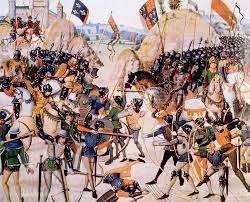The Hundred Years’ War (1337–1453 CE) between France and England was one of the longest and most expensive conflicts in medieval history. Over more than a century of warfare, both kingdoms struggled to fund their armies, fortifications, and military campaigns. With the cost of war skyrocketing, gold became a crucial financial tool—both as a currency for trade and as a backing asset for war loans and debts.
This period marked a significant shift in gold reserves, as European monarchs increasingly turned to gold-backed credit systems, taxation, and financial innovations to sustain their war efforts.

The High Cost of War: Why Gold Was Essential
The Hundred Years’ War drained the treasuries of both France and England. Funding the war required:
- Raising and paying professional armies instead of relying solely on feudal levies.
- Producing and maintaining advanced weapons like longbows, cannons, and siege engines.
- Building and repairing fortifications across France and England.
- Hiring mercenaries, who often demanded payment in gold.
With traditional sources of revenue (land taxes and feudal dues) proving insufficient, both countries turned to gold-backed financial instruments to keep their war efforts going.
England’s Use of Gold-Backed Debts
1. War Loans from Italian and Flemish Bankers
- The English Crown borrowed large sums of gold-backed credit from banking families in Florence (Medici Bank), Venice, and the Low Countries.
- These loans were repaid with future tax revenues and trade profits.
2. The First Government Bonds (“Tallies”)
- England issued tallies, which were essentially government bonds backed by gold and future tax collections.
- This was an early form of state-backed debt financing, allowing England to raise money quickly for war expenses.
3. Gold & The Wool Trade
- England’s biggest source of wealth was the wool trade, particularly exports to Flanders.
- The English Crown often secured loans using wool as collateral, repaying debts in gold florins and ducats.
France’s Financial Struggles and Gold Reserves
1. Heavy Taxation & Currency Manipulation
- The French monarchy heavily taxed merchants and peasants, demanding payments in gold and silver.
- To stretch its reserves, France debased its currency, reducing the gold content in coins—leading to inflation and economic instability.
2. Borrowing from Italian Bankers
- Like England, France also borrowed gold-backed loans from Italian banking families, particularly in Florence and Genoa.
3. Seizing Gold from the Church & Nobles
- French kings confiscated gold reserves from the Catholic Church and powerful noble families to fund the war.
The Role of Gold Coins in Financing the War
During the Hundred Years’ War, both England and France minted new gold coins to stabilize their economies and fund military campaigns.
England’s Gold Noble (1344 CE)
- King Edward III introduced the gold noble, England’s first major gold coin in over 500 years.
- The noble was used to pay mercenaries, fund military expenses, and repay war debts.
France’s Gold Franc (1360 CE)
- After being ransomed following his capture by the English, King John II of France introduced the gold franc to restore France’s economy.
- The gold franc helped finance military recovery and was used for diplomatic payments.
The Shift in Gold Reserves: From Monarchs to Banks
As France and England struggled to finance their war efforts, gold reserves increasingly shifted from royal treasuries to private banks.
- Italian banking families (Medici, Peruzzi, Bardi) became the main lenders of gold to European monarchs.
- The war accelerated the development of gold-backed credit systems, laying the groundwork for modern finance.
- The reliance on gold reserves for debt financing influenced later European conflicts and economic policies.
Conclusion: The Lasting Impact of Gold-Backed War Debts
The Hundred Years’ War demonstrated the strategic importance of gold in medieval warfare. To sustain their war efforts, France and England:
✅ Developed gold-backed credit systems, shaping early financial markets.
✅ Relied on Italian banking networks, shifting economic power to financial centers.
✅ Minted new gold coins, reinforcing the role of gold in European economies.
The war’s legacy extended beyond the battlefield, influencing the rise of banking, government bonds, and centralized financial systems that would define Europe’s later economic history.
